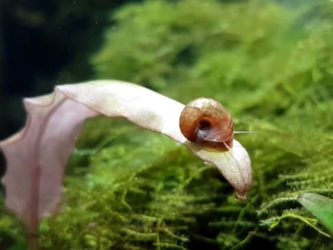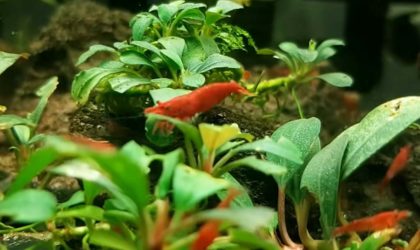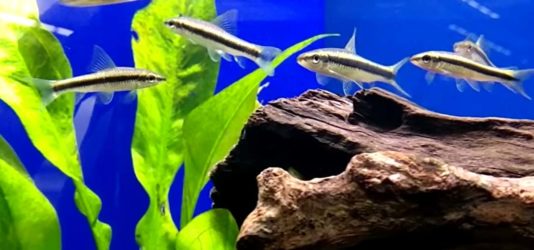Are you frustrated by algae overgrowth? Maybe this is the sign that your fish tank needs some algae eaters. Algae Eaters are aquatic organisms that usually thrive on small plants and algae.
In this, we have tried to cover some of the most common algae eaters as per the tank size available at your home. But before going there, let’s address a few questions.
Table of Contents
Best Algae Eaters For Betta Tank
Here is a list of the best algae eaters for a betta tank:
- Otocinclus catfish
- Nerite snails
- Amano shrimp
- Siamese algae eaters
- Malaysian trumpet snails
- Ghost shrimp
- Cherry shrimp
It is important to research and choose algae eaters that are compatible with bettas and the specific needs of the tank. Some algae eaters may be too large or aggressive for a betta tank, or may have dietary or habitat requirements that are difficult to meet in a small tank.
Is Algae Bad For Your Tank?

No, Algae are vital for the aquatic ecosystem as it’s an essential supply of carbon and nutrients to organisms that feed on them.
Consuming nitrogenous substances can be toxic for fishes. This nitrogen is usually released from the feces and dead vegetation in the ecosystem.
However, algae make things easier. They gather suspended nutrients from the water and synthesize the toxic nitrogen.
Also, they release oxygen as a byproduct which is essential for breathing underwater.
What Are The Reason Behind Algae Growth In Your Tank?
Algae are plants that grow in water, light, and nutrient-rich conditions. Aquariums are ideal breeding grounds because of this. However, algae increases when there is too much sunshine or nutrients in the water.
Several things, including: can cause algae overgrowth
Too much direct sunlight on the tank as a result of leaving the home lights on for an extended period
There is an excessive amount of fish food available.
They are letting too many nutrients build up in the water by changing the water regularly.
Algae Eaters For 5 Gallon Betta Tank (Our Picks)
1. Otocinclus

The gregarious Otocinclus is our overall favorite algae eater.
Otocinclus, often known as a Dwarf Sucker, has a small body size and is excellent for nano tanks.
It fills the need for a tiny algae eater in tanks ranging from 5 to 20 gallons by growing to a maximum size of about 2 inches and lives in social groups of thousands of individual fish in the wild.
Otocinclus, sometimes known as “Otos,” are docile fish that make great tank mates for a wide range of tropical community species.
While Otos will eat whatever algae are available in your tank, supplementing their diet with a high-quality algae wafer is critical for their health and longevity.
Inquire whether the Otos on the show are wild-caught or captive-bred while choosing one for your aquarium.
Also, inquire about the length of time the fish has been in the store.
Otos who have survived more than two weeks in artificial conditions have a higher chance of survival.
Purchasing captive-bred fish is critical to sustaining wild populations, especially in the case of Otos. But unfortunately, the methods used to acquire them in the wild sometimes result in fish dying just days after being carried home by an aquarist.
2. Nerite Snails

Nerite snails are among the most popular algae-eating snail species, thanks to their zebra-like black striped pattern on their shells, making them look unique and a good choice for your fish tank.
These snails consume all varieties of algae, including the more difficult ones like green spot algae, and they work swiftly.
When handling these snails, one thing to keep in mind is that they have difficulty turning over if they land on their backs.
Nerite snails are tiny, growing to over an inch in length, keeping them away from large, predatory fish.
Snails prefer water with a pH of 6.5 to 8.5 and a KH of 12 to 18. They can withstand a wide variety of water temperatures, from 65°F to 85°F, allowing them to adjust to the circumstances in your tank.
3. Ramshorn Snail

If Nerite shrimp isn’t your thing, try a Ramshorn snail instead. They can reach a length of 2cm and enjoy eating algae.
Ramshorn snails slightly have the upper hand over Nerites as they don’t thrive on small live plants in the fish tanks, which maintains the greenery and composure of the aquarium.
However, you should keep in mind that they are animals, and you should expect them to devour your plants, especially if they’re on the verge of passing away.
Another thing to keep in mind is that they have a high reproduction rate. So if you see this, you should consider adding some hitman snails to your tank.
Ramshorn snails can live for up to a year if properly cared for. However, if you add a few to your tank, you won’t have to worry about buying more because they’ll reproduce organically.
It’s difficult to say how many of them you should have in your tank because they reproduce so quickly (and you’ll likely lose the number). Nevertheless, you should start with five and evacuate them when you believe your tank is overcrowded.
Make sure you meet these two conditions before you add Ramshorn snails to your fish tank:
- pH level- 6.5 and 7.5
- Temperature- 70 to 80 F
One advantage of having Ramshorn snails is they get along with a wide variety of water conditions.
Algae Eaters For 10 Gallon Betta Tank (Our Picks)
1. Red Cherry Shrimp

The Red cherry shrimp is also slightly bigger than 5 gallons that can help keep algae at bay.
They look lovely, come in a variety of colors, and you can have a group of them in a 10-gallon aquarium without drastically restricting the amount of fish you may keep.
They can devour a wide variety of algae, including hair algae, once they get down to business. They won’t eliminate it, but they can be an essential part of your overall algae-reduction approach.
2. Endlers Livebearers

Endler’s livebearers are an excellent alternative to Red Cherry Shrimp. However, even when they are similar to guppies, there are a few differences to be aware of. To begin with, they lack the long flowing tails of guppies, and while they are colorful, they are not as vibrant as guppies (especially the females).
Endler’s livebearers aren’t pure algae feeders. Thus, you will have to feed fish flakes, live food, and so on. However, even if you aren’t doing this, you will frequently notice them grazing on algae in your tank. While they aren’t the most delicate algae eaters, they are excellent for maintenance.
If you want to keep Endler’s livebearers in your tank, make sure there are plenty of hiding spots for them. Of course, your betta’s disposition will determine whether or not he attacks them, but if he does, you’ll want them to have somewhere to shelter until you can come up with a more permanent solution.
Endler’s livebearers are tough fish that will thrive in the water conditions that your betta requires. If you’re curious, they require a pH range of 5.5 to 8 and a temperature range of 64 to 84°F.
They’re slightly smaller in size, only reaching a length of just under 2 inches and living for 2–3 years.
If you retain endlers as livebearers, they will give birth to live fry. Your betta should consume this fry. (which will provide it with nutritious food), but you should have enough room to accommodate any fish that grows to adulthood.
Algae Eaters For 20 Gallon Betta Tank (Our Picks)
1. Blue Neon Dwarf Goby

A saltwater tank is required for the majority of the very nice-looking goby species. Exceptions include the blue neon dwarf goby.
What’s more, it can live in a 10-20 gallon tank and consume algae.
It won’t eat the tough algae, but it will consume biofilm and the delicate algae that grow on items.
This species relies on it. Therefore, when you purchase one, ensure you have enormous algae in your tank for it to eat.
2. Twig Catfish

If you can get your hands on a couple of twig catfish, they’ll eat through any algae in your tank in no time. So while they’ll need to supplement their food, algae can provide most of their nutrients.
If you want to keep twig catfish, you’ll need to keep them in pairs. To survive, each pair will require 12 liters of water. However, they should not be kept in a tank smaller than 20 gallons due to their great size. It will provide them with plenty of space to swim and graze.
(Until you keep them in pairs, keeping them in groups of 4-6 is frequently recommended for the highest chance of survival.)
Due to their docile and calm temperament, you should ensure your betta is not aggressive before putting them in your tank. If you’re a beginner fish keeper, you might want to avoid twig catfish because they need a little more attention than the other fish on the list.
If you want to retain twig catfish, make sure the water conditions are suitable. A pH of 6–8 and a temperature of 75–81°F are required.
Twig catfish can reach a length of 4 inches and have 15 years. However, the likelihood of that happening is small as they’re more fragile than other fish.
3. Mollies

Mollies and other livebearers will eat algae from time to time if it is accessible. However, they may not eat it as much as some other fish on this list.
Swordtails and platies are two additional livebearers to consider.
Swordtails are distinct in that they appear in a wide range of colors, and males have a long sword-like extension at the base of their tails that you can use to distinguish them from females. Platies are available in a variety of colors and patterns as well.
Mollies and certain other livebearers are docile fish that do well in community tanks of at least 20 gallons or bigger, depending on the number of fish in the tank.
Mollies often reach a length of 2 to 4 inches and like a pH of 7.5 to 8.5.
Algae Eaters For 30 Gallon Betta Tank (Our Picks)
1. Siamese Algae Eater

You’ve probably never heard of a Siamese algae eater (SAE), as they’re not the most common fish you’ll come across. They do, however, make excellent algae eaters. One of the causes SAEs are so beneficial is because they will consume algae from plants rather than the plant itself. As a result, they’re the ideal cleanup team.
And, as you might expect from their name, algae is their primary food supply. So while you should still supplement their nutrition, putting them in an older tank will make them very happy.
One thing to keep in mind is that while SAEs eat a lot of algae when they’re young, they start to prefer pellets and other foods as they get older.
It’s best to keep SAEs on their own or in big groups if you’re going to keep them. They’ll end up fighting and becoming too territorial if they don’t. While you can keep a single one in a 30-gallon container, a group of five will require at least 40 gallons.
If you plan to keep a bunch of them together, you should avoid red tail sharks because they frequently attack each other.
Another thing to keep aware of is your betta’s and SAEs’ temperament. The flying foxes may try to pinch your betta’s fins if he gets too close to them when they live in various regions of the tanks.
Another reason(s) you should maintain them in a large tank is because of this-SAEs can reach a size of 6 inches and survive for up to ten years.
Furthermore, to give your SAEs the best chance of survival, keep them between 75 and 79 degrees Fahrenheit and a pH level of 6.5 to 7.
Also, Siamese algae eaters should not be confused with Chinese algae eaters. Despite their similar appearance, Chinese algae eaters are far more aggressive.
2. Rabbit Snail

If you’re not confident if your betta will get along with fish, then putting a rabbit snail could be a fair idea.
Rabbit snails will devour any algae in your tank and should be kept away from most live plants. They are mostly known to chew on java fern, however. If they go out of algae, they’ll begin to devour the living plants in your tank.
You might be wondering why a rabbit snail should be kept in such a large tank. Before the fish becomes wholly mature, they’ll do just well in tanks as small as 10 gallons. When they do reach full size, though, it is usually around 5 inches.
Another excellent reason to include rabbit snails is that they do not reproduce quickly. So it won’t become overrun when you add rabbit snails to your tank. Instead, they reproduce at a rate comparable to assassin snails.
Remember that if you have snails in your tank, you must be extra cautious with any drugs or fertilizers you use because they could be poisonous.
Another thing to keep in mind is that you’ll need to raise the pH level in your tank slightly. While a betta prefers a pH of 7, rabbit snails require a pH of at least 7.4. However, both should be good somewhere in the midst of the two. You should also keep the water temperature for your rabbit snail between 76 and 84 degrees Fahrenheit.
3. Bristlenose plecos

If you are going for bigger tank sizes, like 30 gallons, you can add Bristlenose plecos to your aquarium after it reaches 25 gallons. If you decide to do this, make sure the tank’s bottom has plenty of areas and isn’t fighting over territory.
Plecos can thrive on algae, but most of the time, restricting to only one source of nutrition may not be enough.
Even though they’ll be eating essentially plants (mainly algae), you need to boost their diet with protein. You can accomplish this by adding freeze-dried or frozen foods such as daphnia and brine shrimp.
If you want to retain bristlenose plecos in your tank, make sure the pH is between 6.5 and 7.5 and the temperature is between 60 and 80 degrees Fahrenheit.
They can reach a length of 5 inches and survive for 5 years. One of the factors they’ll require a bigger tank is their size.
Remember that they’re also gentle and naturally quiet, so even if your betta is aggressive, it’s best to keep them out of your tank.
Algae Eaters For 55+ Gallon Betta Tank (Our Picks)
1. Amano shrimp

Amano shrimp are a great alternative to snails. Because of their small size, Amano shrimp make excellent tank companions. Due to an Amano shrimp’s enormous size, you won’t have to worry about other fish in the tank, especially your betta, eating them.
Because of their ability to survive, Amano shrimp are excellent starter shrimp. If your tank is well-stocked with algae, you won’t need to supplement their food very often. However, once a week, a handful of algal wafers or blanched zucchini will make them ecstatic.
Make sure you have plenty of live plants and hiding spots for them. Then, not only will they feel more at ease, but they’ll also have more places to hide during molting until their tough exoskeletons return.
The sole disadvantage of Amano shrimp is that they do not have the most appealing appearance. They have clean skin with stripes and dots that go up to their sides.
Also, whenever you add a new creature to your tank, you must go with caution. For example, while your betta should be fine with them, shrimp are commonly mistaken for food by bettas and other fish, especially after they’ve molted.
Your Amano shrimp will reach a maximum size of 2 inches and survive for 2 to 3 years.
They also thrive in a temperature range of 68 to 86 degrees Fahrenheit and a pH range of 6.5 to 7.5.
What Are The Benefits Of Algae Eaters In A Betta Tank?
Your tank life may grow pretty well on its own after you construct your tiny ecosystem. However, algae eaters exist in various sizes and shapes, and they can help your aquarium.
Algae eaters get that name for a reason, although they eat more than algae. They also limit the number of leftover food particles, detritus, and decaying plant material in the water, all of which might contaminate it.
Despite the need for filtration systems and plants, algae eaters can shoulder most of the burden. Of course, some animals in this category are more efficient than others, but they all contribute somehow.
Conclusion
The algae-eating fish mentioned in this article aren’t the only ones around. Many fish will eat algae, albeit not as effective as the fish and invertebrates listed before.
Mollies, for example, are notorious for picking algae off of glass and decorations.
Mollies are significantly less efficient than a devoted algae eater like an Otocinclus or even a bunch of Red cherry shrimp. Hence they didn’t make the top 10 algae eaters list.
Not only do the bristlenose catfish eat algae, but so do other “suckerfish” species.
Plato’s and sucker catfish come in a wide range of colors and fin forms, but they’re more expensive and difficult to come by.
Fortunately, the fish mentioned in this article are relatively widespread and are readily available depending on where you live.
If you’re thinking about getting an algae eater for your aquarium, We hope this guide helped you figure out which fish to get.
